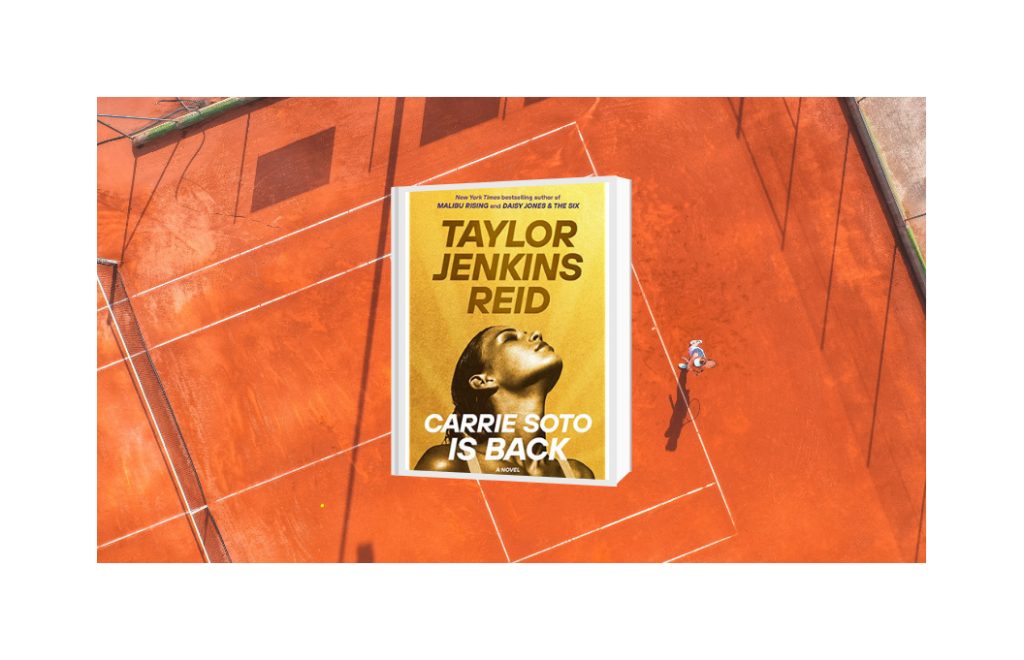If you’re a zillennial who exists on social media, it is unlikely that you’ve missed the hype around Taylor Jenkins Reid (TJR) and her novels. TJR was first launched into my periphery with her novel The Seven Husbands of Evelyn Hugo which took on a feverish fan base on Tik Tok. It was hard not to encounter one of the hundreds if not thousands of tribute videos that were made to the fictional characters, with stylised interpretations of old Hollywood glamour and opulence which have been romanticised in the 21st century.
TJRs popularity began accelerating at a rapid speed as her other bestsellers, most notably Malibu Rising and Daisy Jones and The Six started making the rounds on booktok. After hearing countless recommendations across Instagram, Tik Tok and even podcasts, it was time for me to pick up her most recent novel, Carrie Soto is Back, and see what the fuss was all about.
Full disclaimer, Malibu Rising was a DNF for me. I made it about 30% of the way through (if not less) but felt zero connection toward the characters, who seemed to lack substance and were unrelatable in their privileged white-person dramas. I really couldn’t find the spirit to see how their stories ended. But with Daisy Jones and the Six hitting our screens in a critically successful TV adaptation, and the TJR hype not slowing down, it was about time for me to give her another chance. Carrie Soto seemed to be a great place to start.
The Plot
Carrie Soto, the daughter of professional Argentine tennis player Javier Soto, was destined to be the world’s greatest tennis star. With her father as her coach, she began her professional career in the 1970s at age 13. She became no.10 in the world at only 17. By 29, she achieved what she set out to become: “the most decorated tennis player by nearly every measure”.
The book begins with Carrie, now a retired 37-year-old tennis star with a bad knee, watching on the sidelines as current great Nicki Chan ties her record for the most singles slam titles. It is there, alongside her father and coach Javier, that she decides to stage a comeback and reclaim her record by competing to win in all Grand Slam Tournaments of 1995.
From this point, Carrie begins a gruelling undertaking, training not to become her former self, but someone better, in the face of public cynicism and personal shortfalls. With the coaching genius of her father, and Bowe Huntley, a fellow player facing the twilight of his career, Carrie “The Battleaxe” wages war.
My thoughts (Spoiler alert!)
Miraculously, Taylor Jenkins Reid manages to create a lovable character out of some truly unlikeable traits. Carrie is seen as cold, heartless and more machine than human by fellow players, commentators and the public. Her bloodthirsty game on the court wins her the name of “The battleaxe” or, by those who see her even less favourably, “The bitch”. Despite this characterisation, readers can empathise with Carrie’s abrasive personality, which is a direct result of a life where winning is the only thing that truly matters, and anything short of perfectionism is a failure.
From the beginning, it is impossible not to root for Carrie, flaws and all. She persists against the vitriol that she endures, as a woman who refuses to play along to feminine ideals, particularly in sports. The book grapples with the societal rejection of an aging woman and the expectations and prejudices that are placed on women’s shoulders in a world set up for men. As a female reader, this is something that resonates beyond the novel’s 20th-century context.
“We live in a world where exceptional women have to sit around waiting for mediocre men.” – Carrie Soto, Carrie Soto is Back by Taylor Jenkins Reid
One of my favourite things about this book was TJRs ability to craft dynamic character relationships that stay with you long after the final page. Carrie’s relationship with her father, Javier lays the foundation for who she becomes as a person, both in her success and in her shortcomings. As their relationship develops and they come to understand each other, we can see the impact on her overall development as a character. Carrie’s relationship with Bowe, the love interest, provides us with an insight into her character’s overall development throughout the novel, as we see a shift in her willingness to be vulnerable and her ability to trust. Meanwhile, Carrie’s interactions with Nicki Chan, her ultimate competitor on the court, work to reinforce the tribulations of a female athlete who doesn’t fit the preferred blonde-haired, blue-eyed mould that is preferred of a woman in the public eye. Ironically, it is this relationship that provides the ultimate insight that allows Carrie to see herself outside of the life of tennis that she has only ever known.
The Tennis
Speaking of tennis, let’s discuss it. From my online encounters with those who have read, or are contemplating reading this book, tennis appears to be the major concern for non-sport lovers. As someone who is not particularly interested in sports, a book about a tennis player making a comeback did not exactly excite me. But reviews of the book consistently pedalled something along the lines of “Don’t let the whole tennis thing dissuade you, it’s so good!”. After reading I must agree, Reid nailed it. The depiction of each match is sharp, fast and gripping, and was actually what made the book such a page-turner for me. So I encourage those who are apprehensive about the tennis factor to not let this faze them. What I will say though, is that this book is HEAVY on tennis. If you’re expecting it to be all about tennis then you’re 100% right. What you should know is that the tennis matches act not only as an exciting plot point but are a reinforcement of the underlying themes of perseverance, connection, struggle and identity throughout the novel, perfectly capturing the context of the plot beyond them. The strong, unrelenting focus on tennis throughout the novel is necessary to portray a protagonist whose whole existence has revolved around the game and nothing else.
The Representation Debate
In reviewing Carrie Soto is Back, a novel with a Latinx main character, I do need to address the elephant in the room when it comes to TJR. Reid has received significant backlash, both in online spheres and from critics, on her portrayal of POC as a Caucasian woman. Her use of main characters that are racial minorities has been a topic of contention and is something that I feel uncomfortable about.
Reid is well aware of this criticism, to which she has responded;
“The way I see it, I have two options. I can write only about women that look like me for the rest of my career, in which case I continue to centre white women and make women of colour peripheral. Or I can meaningfully try to include people different from me in the centre of these stories and do it with an open heart—and the understanding that intention does not equal impact. I definitely hear the criticisms when they come, and I take them to heart.”
From my first encounter with a TJR novel that places a woman of colour at the centre of the story, I will say that her good intentions have unfortunately fallen short of their promise. Reading Carrie Soto is Back, and hearing reviews from Latinx readers, it is clear that while centring a woman of Argentinian blood in this story, Reid does little beyond her repetitive and inaccurate use of Argentinian Spanish to offer cultural substance. I feel more care and research should have been given to Carrie’s portrayal as an Argentinian woman, as was given to her portrayal as a tennis player. Some critics have also raised concerns that a white woman’s depiction of a Latinx voice takes up space where a Latinx writer’s voice could be heard. But in a system that will continue to platform white writers over POC, is it better to encourage the use of minority voices in the writing of white authors, or only accept these representations from someone who has the lived experience of existing as a POC? As a white person myself, I would recommend reading more detailed discussions of this issue from those with lived experience, Feminist Book Club in particular provides a greater insight into this discussion.
With these points in mind, I will leave you with my final thoughts on the novel. Carrie Soto is Back deals with some really important themes and continually makes effort to represent them from an intersectional point of view. We see a woman beyond her ‘prime’ continually show up in defiance against a world that would rather see her disappear. The story is powerfully feminist and offers experiences from both a Latinx woman in Carrie (if a little lacklustre in the execution) and of a queer Asian woman in Nicki Chan. The relationships that unfold are truly captivating, as is Reid’s ability to depict tennis as if one was watching the highlights on television. As match after match keeps you turning the page, it is the highs and lows of the protagonist and the character evolution that will absorb you into Carrie’s story.




